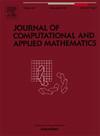基于域正则化的滑坡厚度估计
IF 2.6
2区 数学
Q1 MATHEMATICS, APPLIED
Journal of Computational and Applied Mathematics
Pub Date : 2025-09-27
DOI:10.1016/j.cam.2025.117073
引用次数: 0
摘要
本文介绍了一种新的基于域的正则化方法,利用地表速度数据估计滑坡厚度。这样的数量对于准确评估滑坡行为、潜在影响和相关风险至关重要。在这里,我们将该问题表述为一个不适定逆问题,并提出了一种基于水平速度大小相等的若干区域的滑坡域分解的多惩罚正则化方法来求解该问题。我们扩展了平衡原理,以适应跨分解区域的非恒定平衡参数。我们的基于域的最大化最小化算法收敛于满足这一扩展原理的解,与传统方法相比表现出优越的性能。通过对合成和真实滑坡数据的严格测试,我们表明基于速度场均匀性的策略域分解提高了估计精度。我们的研究结果表明,虽然过度细分会适得其反,但确定适当的基于速度的宏观区域会产生最佳结果。该方法为滑坡风险评估和监测提供了更可靠的厚度估计。本文章由计算机程序翻译,如有差异,请以英文原文为准。
Estimating landslide thickness through domain-based regularization
This paper introduces a novel domain-based regularization approach for estimating landslide thickness from surface velocity data. Such quantity is crucial for accurately assessing landslides behavior, potential impact, and associated risks. Here, we formulate the problem as an ill-posed inverse problem and propose, for its solution, a multipenalty regularization approach based on the decomposition of the landslide domain in several regions with uniform magnitude of the horizontal velocity. We extend the Balancing Principle to accommodate non-constant balancing parameters across decomposed regions. Our Domain-based Majorization-Minimization algorithm converges to solutions that satisfy this extended principle, demonstrating superior performance compared to traditional methods. Through rigorous testing on both synthetic and real-world landslide data, we show that strategic domain decomposition based on velocity field homogeneity enhances estimation accuracy. Our findings reveal that while excessive subdivision is counterproductive, identifying appropriate velocity-based macro-regions yields optimal results. This methodology provides more reliable thickness estimates crucial for landslide risk assessment and monitoring.
求助全文
通过发布文献求助,成功后即可免费获取论文全文。
去求助
来源期刊
CiteScore
5.40
自引率
4.20%
发文量
437
审稿时长
3.0 months
期刊介绍:
The Journal of Computational and Applied Mathematics publishes original papers of high scientific value in all areas of computational and applied mathematics. The main interest of the Journal is in papers that describe and analyze new computational techniques for solving scientific or engineering problems. Also the improved analysis, including the effectiveness and applicability, of existing methods and algorithms is of importance. The computational efficiency (e.g. the convergence, stability, accuracy, ...) should be proved and illustrated by nontrivial numerical examples. Papers describing only variants of existing methods, without adding significant new computational properties are not of interest.
The audience consists of: applied mathematicians, numerical analysts, computational scientists and engineers.

 求助内容:
求助内容: 应助结果提醒方式:
应助结果提醒方式:


